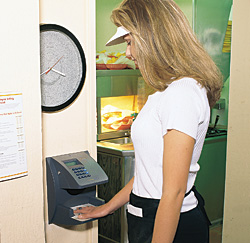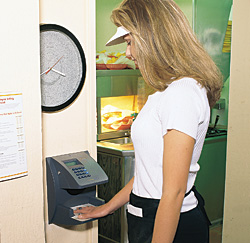
Biometrics To Go
Terminals hand fast food outlets quick paybacks
- By Bashar Masad
- May 30, 2007
 CONTRARY to using badges, sign-ins or other ways of tracking employees, a biometric reader ensures no employee can punch in for another, eliminating time fraud and reducing payroll costs. Because every person's biometric features—hand, fingerprint, eye or face—are unique, a biometric time clock provides a quick, accurate and reliable way to record in and out punches for each employee. That’s why so many companies, including fast food restaurants, now employ biometrics.
CONTRARY to using badges, sign-ins or other ways of tracking employees, a biometric reader ensures no employee can punch in for another, eliminating time fraud and reducing payroll costs. Because every person's biometric features—hand, fingerprint, eye or face—are unique, a biometric time clock provides a quick, accurate and reliable way to record in and out punches for each employee. That’s why so many companies, including fast food restaurants, now employ biometrics.
A biometric reader ensures payroll accuracy by simply requiring each employee to be present—no cards or other credentials are needed. Losses due to buddy punching are eliminated. Using scheduling restrictions, unauthorized early-in and late-out punches are eliminated. The hardware also is typically less than 10 percent of the overall cost for a time and attendance system so biometric readers can be affordably placed in multiple locations. With biometrics, many companies report savings of up to 5 percent of total payroll cost.
Sweet Paybacks
Alliance Management in Avanel, N.J., a Dunkin’ Donuts franchisee with stores in Middlesex, Mercer and Cherry Hill counties, is using biometric readers in 27 of tits stores, with three more pending, to record time and attendance information for more than 300 employees. The readers automate time recording and control labor costs.
“We were using timecards, but had numerous problems with them, including employees losing cards. Plus, our time clocks were old and had to be replaced,” said Margaret Hanna, office manager for Alliance Management. “The new HandPunch readers have made payroll much easier. We have saved money and received payback within months.”
“This Dunkin’ Donuts franchisee wanted more accurate, automated record keeping and to control labor costs,” said integrator Fred Overbeck of Automated Time Concepts of Glen Head, N.Y. “The stores have lower-paid employees with a high turnover rate, and the franchisee was concerned with buddy punching.”
Overbeck said he believes in hand geometry technology.
“Hand geometry readers are the most reliable and easy to use,” he said. “Finger-scan readers are not consistent, plus the HandPunch is more tolerant to subtle changes such as sugar- or dough-coated hands.”
Now, instead of filling out or punching timecards, employees at Dunkin’ Donuts shops simply place their hands on the HandPunch. It automatically takes a 3-D reading of the size and shape of the employee’s hand and verifies the user’s identity in less than a second. Employees use the units twice a day to punch in and out. Store managers edit punches and forward pay files to the company’s in-house payroll department, which uses QuickBooks. Payroll is done bi-weekly.
“Problems we were having with the timecard system at Dinkin’ Donuts have been alleviated,” Hanna said. “The first and last thing an employee does each day is go to the HandPunch. All employees use it, including office administration. We now get our time sheets and time reports all on one sheet. The biometric system is much easier to use. More importantly, we’ve had no complaints or problems with the readers.”
Biometrics Goes Global
In Venezuela, 85 McDonald's restaurants are cutting payroll costs by up to 22 percent annually after incorporating biometric terminals. More than 3,400 employees have been enrolled in a biometric time clock system in the past four years. On average, the system generates more than 7,500 transactions each day, resulting in 2.5 million punches annually.
"McDonald's moved to biometrics because officials wanted to verify that the employee clocking in was really that person," said McDonalds’ Brenda Morales. "Students make up about 90 percent of the McDonald's workforce in Venezuela. They were frequently punching one another in to cover for exams or other school-related events.
“A card only verifies a card. We have used finger scanning for other applications, but we believe that hand geometry is more effective and produces fewer errors when there are larger employee populations. With hand geometry, a larger area is scanned than with finger scans, and the template is updated after every scan so it remains current.”
As fast food restaurant managers have discovered, biometric-based systems have many benefits. There are no badges to issue, replace when lost or stolen, or recover when an employee leaves or is terminated. Their hand is their badge. The system helps curb problems of employees buddy punching for friends. After a biometric reader is installed, many companies are stunned to discover how much buddy punching actually costs them. And there is no more data entry errors when calculating payroll or recording attendance. A plug-and-punch feature enables some readers to be installed in less than 15 minutes.
Supervisors at each McDonald’s franchise, who also clock in and out each day on the terminals, now use the HandPunch terminals to authorize and verify employee time and overtime on a computer located at the store. The hours are sent to a central payroll processing center via a phone line.
"Most supervisors at McDonald's are promoted from within, and many find it difficult to impose rules and restrictions on their fellow workers,” Morales said. “The use of biometrics ensures that everyone is treated the same and fairly. McDonald's employees are satisfied with the HandPunch because payroll information is processed quickly and without mistakes. They receive regular reports with information about time and attendance."
According to Morales, language is not an issue because the software is in Spanish, and the readers accommodate several languages.
As fast food restaurants have found, biometrics ensure that employees earn a day’s pay only when they are present to do a day’s work. Whether the restaurant franchisee has 50 or a thousand employees, biometric-based time and attendance terminals produce more accurate payrolls and reduce labor costs. The technology also cuts operating costs and increases employee convenience by eliminating the need for badges—all while enhancing the bottom line.